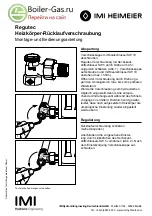
13
LP- 446 REV. 9.3.14
C. CLEARANCES FOR SERVICE ACCESS
See Figure 3 for recommended service clearances. If you
do not provide the minimum clearances shown, it might not
be possible to service the boiler without removing it from the
space.
D. RESIDENTIAL GARAGE INSTALLATION
PRECAUTIONS
If the boiler is located in a residential garage, per ANSI
Z223.1:
Mount the bottom of the boiler a minimum of 18”
above the floor of the garage, to ensure the burner and ignition devices are well off the floor.
Locate or protect the boiler so it cannot be damaged by a moving vehicle.
Check with your local Authority Having Jurisdiction for requirements when installing boiler in a garage. Please read the entire manual
before attempting installation. Failure to properly take factors such as boiler venting, piping, condensate removal, and wiring into
account before installation could result in wasted time, money, and possible property damage and personal injury.
E. EXHAUST VENT AND INTAKE PIPE
Vents must be properly supported. The boiler exhaust and intake connections are not designed to carry heavy weight. Vent support
brackets must be within 1’ of the boiler and the balance at 4’ intervals. Venting must be readily accessible for visual inspection for the
first 3’ from the boiler.
The boiler is rated ANSI Z21.13 Category IV (pressurized vent, likely to form condensate in the vent), and requires a special vent
system designed for pressurized venting.
You must also install intake piping from outdoors to the boiler flue adaptor. The resultant installation is categorized as direct vent
(sealed combustion).
Note: To prevent combustion air contamination, see
Table 3
in this section when considering exhaust
vent and intake pipe termination.
Exhaust vent and intake pipe must terminate near each other and may be vented vertically through the roof or out a side wall. Exhaust
vent and intake piping methods are detailed in the Venting Section. Do not attempt installation using any other means. Be sure to locate
the boiler so exhaust vent and intake piping can be routed through the building and properly terminated. The exhaust vent and intake
piping lengths, routing and termination method must all comply with methods and limits given in the venting section.
F. PREVENT COMBUSTION AIR CONTAMINATION
Install intake piping for the boiler as described in the Venting section. Do not terminate exhaust in locations that can allow
contamination of intake air.
You must pipe outside air to the boiler intake. Ensure that the intake air will not contain any of the contaminants below. For example, do
not pipe intake near a swimming pool. Avoid areas subject to exhaust fumes from laundry facilities. These areas always contain
contaminants. Contaminated air will damage the boiler, resulting in possible substantial property damage, severe personal injury, or
death.
Space must be provided with combustion/ventilation air
openings correctly sized for all appliances located in the
same space as the boiler. The boiler venting cover must
be securely fastened to prevent it from drawing air from
the boiler room. This is particularly important if the boiler is
in a room with other appliances. Failure to comply with the
above warnings could result in substantial property
damage, severe personal injury, or death.
Figure 3 - Clearances
Содержание 500 HL
Страница 12: ...12 LP 446 REV 9 3 14 Figure 2 Dimensions and Specifications ...
Страница 21: ...21 LP 446 REV 9 3 14 H PIPING DIAGRAMS Figure 6 ...
Страница 44: ...44 LP 446 REV 9 3 14 E GAS VALVE Figure 26 Mod Con 500 Gas Valve ...
Страница 52: ...52 LP 446 REV 9 3 14 Figure 33 Mod Con Internal Connection Diagram LP 428 K ...
Страница 71: ...71 LP 446 REV 9 3 14 Figure 36 ...
Страница 72: ...72 LP 446 REV 9 3 14 Figure 37 ...
Страница 73: ...73 LP 446 REV 9 3 14 Figure 38 ...
Страница 74: ...74 LP 446 REV 9 3 14 Figure 39 ...
Страница 77: ...77 LP 446 REV 9 3 14 ...
Страница 78: ...78 LP 446 REV 9 3 14 ...
Страница 79: ...79 LP 446 REV 9 3 14 MAINTENANCE NOTES ...














































